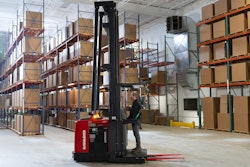
The grocery distribution center of the future has arrived—and you can find it just north of Toronto.
Sobeys Inc.’s new highly automated distribution center, in Vaughan, Ontario, is the first of its kind in Canada. The facility can handle an amazing 320,000 cases per day—three times the number of Sobeys’ conventional DCs—and can ship more than 1.4 million cases per week.
The size of eight football fields at 500,000 square feet, the Vaughan facility services the dry grocery needs of Sobeys Ontario network of food stores operating under the Sobeys, Foodland, FreshCo and Price Chopper banners. The DC is the largest of its 23 distribution centers, featuring a ceiling height of 65 feet and 30 receiving bays and 41 shipping bays. The centerpiece is an automated case-picking system that builds mixed SKU pallets in a store-friendly and aisle-ready fashion.
Founded in 1907, the company is more than 100 years old, but that doesn’t stop Sobeys from being among the most forward-thinking retailers in Canada. “Retail is rapidly changing and very competitive and we need to keep up with the times. We wanted to be able to improve service levels at the lowest possible cost,” says Francois Vimard, chief financial officer. “The only way to do that was with an automated DC.”
A multi-million dollar investment, the DC reflects Sobeys’ ongoing commitment to innovation. The retailer decided to build the DC in Ontario because that is where it has the largest concentration of stores. “With an automated DC, you need sufficient volume to justify the investment in automation, and Ontario offered us that,” says Vimard.
Vimard, a 15-year veteran of Sobeys, oversaw the design and construction of the facility, which began in 2007. The building was completed in October 2008. “Once the building was finished, it took about a year to install and test the automation technology,” says Vimard. “We began shipping product in July 2009.”
The company consolidated grocery from its Milton and Whibty distribution centers into the Vaughan facility, leaving those two DCs to focus on fresh products including meat, produce and dairy.
“Prior to opening the Vaughan facility, we had some capacity issues in terms of assortment and volume, and we were integrating more and more DSD in our network to improve the service levels to our stores as well as to provide a better assortment,” says Vimard. “That was bringing our cost per case up, so we wanted to get more products into the network with less cost. We also needed to better control our inbound flow from our vendors.”
Employee retention and a shrinking labor pool were also concerns. “Like most grocery distributors, we have high turnover in our DCs, and the Canadian Centre for Occupational Health and Safety [Canada’s version of OSHA] may pass regulations that restrict the amount of weight an employee can move in one day,” says Vimard. “In addition, the population is aging and we realized that if we didn’t find a solution, in 15 years we were going to have a serious labor problem.”
Searching For A Solution
Just like in the United States, competition in the grocery arena in Canada is fierce. With more than $15.2 billion in annual sales, Nova Scotia-based Sobeys is the second largest supermarket retailer in Canada, trailing behind Loblow Cos. Ltd., which posted $27 billion in sales last year. And Wal-Mart Canada Corp. continues to expand, with plans to open 35 to 40 more supercenters this year, adding to the 85 it already operates. The supercenters combine general merchandise with a full supermarket.
Sobeys, like many of its U.S. counterparts, grew through acquisition. At one point, the company was operating 17 separate POS systems under four different legacy systems across Canada. “It was a great challenge for the organization just to get basic information,” says Vimard. “To get to the next level, we had to invest in both technology and logistics and we had to integrate them coast-to-coast so we could have a full view of the business.”
The company tackled technology first and implemented SAP in 2005, which required it to address the data quality issues in its legacy systems. Vimard points out that an ERP system is not necessary to automate a warehouse, “but it does help to have a strong foundation in place and the quality of the information we had with SAP certainly helped with the implementation. The quality of the data is critical—the better the data, the better the system will run.”
Sobeys decided to see what solutions were available and, with the help of an outside consultant, developed an internal roadmap in about six months. After a visit to a Kroger DC in Phoenix that was designed by Witron Integrated Logistics, Arlington Heights, IL, the company realized it had found its automation partner.
“We liked what we saw in Phoenix,” says Vimard, “and Kroger’s business was similar to ours. We sat down with Witron and made sure that we were talking the same language. We discussed how we’d cover peak periods, how we’d handle a challenging time in the day when we have a special promotion—all of those things that differentiate one retailer from another.”
The automation process begins as products are received at the DC and checked in to inventory. From this point, the automation takes over as products are stored in a pallet AS/RS. That automated pallet storage system replenishes a miniload AS/RS case buffer that feeds automatic pallet-building machines. Each store’s order is assembled case by case, the optimal sequence according to the actual physical design layout of that particular store, facilitating faster and more efficient shelf stocking.
Vimard says that near perfect order accuracy practically eliminates out-of-stocks, so Sobeys can provide its customers with the selection of products they’re looking for. In addition, bringing more DSD volume in-house means fewer trucks at the back doors waiting to be unloaded. “So we have more store staff available to help our customers,” he says. “And since the pallets are automatically built according to each individual store layout—basically one aisle per pallet—we’ve reduced labor at the store as well as product damage.”
The automation includes 11 AS/RS pallet cranes that service 38,000 locations and 32 AS/RS miniload cranes with access to 340,000 tray locations. As the systems integrator, Witron manages all processes below the SAP level with its own information technology, material flow and control applications.
COM: The Show Stopper
The majority of case picking is completely automated through the use of Witron’s proprietary OPM (order picking machinery) picking system. Pallets are automatically assembled through Witron’s 16 COM (case order machines) that are installed in the warehouse. The COM is fed by the tray AS/RS system. In addition, a three-aisle “pick to pallet” system with voice control and automated replenishment supplements the automated system in order to handle peak volumes as well as bulky goods.
The COM is the crucial element of the picking system. Typically, automated case picking systems use a vacuum and grab process, which limits the types and sizes of cases that can be lifted and put on the pallet. In addition, this process leaves space between the cases. The COM is very different. It allows cases to be automatically stacked on top of pallets in a store-friendly sequence, without any gaps around the cases. The system can pick cases consisting of different package types, sizes, volumes and weight—up to 95 percent of the typical retail assortment.
The OPM’s replenishment algorithms use forecasting and historical data to ensure the miniload case buffer has the product needed to fulfill the next two to three days of store orders.
The COM was the deal maker for Sobeys. “When we saw the COM at work in the Kroger DC in Phoenix, we were flabbergasted,” says Vimard. “Our picking operation was very costly, it had the most employees, the most breakage and the most challenges in terms of building a pallet, and here the COM was doing it automatically. Witron had cracked the code. At that point, we just had to figure out if it was sustainable over the long term. We visited other distribution centers that were using the COM, and decided that it was worth the investment.”
Witron says the OPM and COM have drawn the attention of major supermarket retailers throughout the world. Kroger has installed the system at three of its distribution centers; a fourth is in the works. Witron expects more retailers to follow suit.
“The OPM delivers the biggest bang for the buck in terms of manpower reduction,” says Chris DeLisle, a senior engineer at Witron. “But there are a number of benefits that are often overlooked—and yet just as important. Delivering store-friendly pallets helps increase labor and efficiency savings at the store. Then there’s a transportation savings because they’re building a denser pallet so they generate more cube on the same trailer.”
Vimard reports that Sobeys is getting about eight percent to 10 percent more product on a pallet. “And the pallet is built so straight that the first time we opened a truck using automation, everyone was astounded,” he says. “The pallets didn’t fall all over the truck and there was no product damage.”
According to DeLisle, other benefits include lower case damage, lower mispicks and better inventory control, as well as human resource paybacks, such as a reduction of injury claims. “We find that employee retention improves as well,” says DeLisle. “Employees say their job satisfaction is much higher because they’re engaged in something they find stimulating—their work environment is now computers instead of boxes, so we find a lot less turnover in the warehouse.”
Room For Growth
With the Vaughan DC in operation for a little more than a year, Sobeys has realized impressive results. Case-handling costs have decreased by more than 50 percent and order accuracy rates by nearly 100 percent. In addition, damages have decreased, transportation savings have increased and the cycle time to process an order has shortened.
Vimard points out that success would not have been possible without the engagement of the company’s management team and employees.
The retailer built the DC larger than it needed to and designed the automation so that it can increase capacity by 50 percent if necessary. Vimard says it’s sustainable for up to 25 years and anticipates that it will handle volume for existing stores as well as new stores.
“With this type of DC, you have invested as much on the automation as you have invested in the building itself—and that’s a big bet,” says Vimard. “And you have to understand your business as well as you can when you’re making the bet. But I’m confident that we’ll get a payback that meets or exceeds our expectations.”
Sobeys has partnered with Witron to run the facility. Witron has personnel on site to operate and maintain the technology while Sobeys employees handle the shipping and receiving.
“Our employees have really embraced the technology,” says Vimard. “We are providing new tools that enable them to get the job done well, while improving levels of performance. The benefits to our vendors, to Sobeys as a corporate entity, to the retail stores and ultimately to our customers have been enormous.”
Food Logistics recently spoke with Karl Hoegen, Witron’s CEO North America.
What is Witron’s “down to earth” culture all about?
Hoegan: Witron is a family owned company that was founded in 1971. We adhere to our values of integrity, commitment and partnership. We are responsible-minded, competent, reliable and predictable, and we possess a very strong work ethic. Our “down-to-earth” culture gives us long-lasting relationships with our customers, illustrated by the fact that nearly 80 percent of our business is repeat.
What are the key distribution and logistics challenges that today’s food retailers are facing, and how does Witron help them overcome these challenges?
Hoegan: We see two key ergonomic drivers: legislation and an aging workforce. Some European countries are placing limits on the amount of weight an order selector can lift during a shift. In some distribution operations, we see pickers lifting 16,000 to 20,000 lbs. per shift, resulting in increased potential for injury, higher error rates, more case damage, and greater employee turnover.
Some companies are having difficulties finding people willing to work in a warehouse. Ten to 15 years from now, over 23 percent of the U.S. population will be 60 years of age or older. The pool of potential employees continues to shrink. As a result, we need to focus on improving the work environment through automation.
Seven years ago, Witron developed an automated case picking and palletizing system we call OPM (Order Picking Machinery). The OPM can automatically pick and palletize over 17,000 different SKUs in a store-friendly sequence. This automatic pallet building means 100 percent picking accuracy, less case damage and quicker shelf replenishment, ultimately leading to increased customer satisfaction in the retail store.
Witron is well-known for its innovative material handling solutions, such as the COM (case order machine). What drives this innovation?
Hoegan: Our deep partnerships with customers allow us to collaborate on technology and solutions that can give companies a competitive advantage in their market. Kroger was the company that challenged us to come up with the COM solution. As a result of that success, our COM equipment processes 2.5 million cases creating approximately 35,000 order pallets each day worldwide. We continue to focus on the “3-E’s” when designing our solutions—ergonomics, efficiency and economics.
What are some of the most recent innovations that Witron has developed?
Hoegan: The ETP (ergonomic tray picking) system was recently introduced to the market place as an “intermediate level” of automation. Although picking is still manual, pick front replenishment is completely automated. In addition, the transport of the picker to the pick location is system-guided, with the picker riding on a man-aboard crane. The height of the order pallet or roll container carried by the man-aboard crane is automatically adjusted relative to the height of the goods in the pick slot, so the picker never needs to lift during picking.
The system calculates the pick sequence and indicates the pick-to location on the order pallet or roll container such that stability, density, and store friendliness can be maximized. No bending, stooping, lifting or carrying by the order selector yields pick rates of up to 500 cases per hour. Having a taller, more densely packed order pallet yields transportation savings of eight to 12 percent as reported by some of our customers. With fuel rates continuing to increase, transportation savings is a big focus for companies.
How do Witron’s solutions help customers become more energy efficient?
Hoegan: Witron’s focus on space-efficient designs enables a significant reduction in energy (lighting and HVAC) compared to conventional designs. In fact, a typical Witron-designed DC has half the footprint of a conventional DC sized to handle the same volume. Energy savings are particularly important when considering frozen and temperature-controlled environments.
Energy efficient planning is not just for new facilities. This issue also plays an important role in the refurbishment of older facilities and maintenance of the “installed base.” Witron regularly conducts energy audits on its existing installations and suggests changes that can be made to reduce waste.
How do you differentiate yourself from your competitors?
Hoegan: As a general contractor, Witron is responsible for the budget, schedule and activities throughout all phases of a project: from conception and planning, to installation, and on through the ramp-up phase. Even after the project has been completed, Witron offers a lifetime of customer support. Our clients love having one point of contact for their project. Being privately owned, we believe we are more innovative and nimble with our leading edge solutions. For example, in Europe, our customers are building ¼ size and ½ size pallets for end caps and display picking using the OPM system. We designed the OPM and HBW (high bay warehouse) with the ability to build and handle these types of pallets giving the customer more flexibility from the distribution center to the store floor.
What direction do you see the food industry going in terms of warehouse automation?
Hoegan: We see automation and ergonomic solutions becoming more prominent in the food industry because of the pressures to gain competitive advantage and improve employee retention. Companies see the need to lower their handling costs while simultaneously improving the working environment.
What does the future hold for Witron?
Hoegan: Our customers are starting to “pull us along” into other areas of their operation such as automatic shelf replenishment in their retail stores. We are testing technology that can be used inside the store to automatically replenish and front a store shelf. This will help provide the customer with a better shopping experience marked by clean aisles and shelves always stocked with product available for purchase. We will continue to be an innovator of ergonomic, efficient and cost effective logistics solutions that give our customers an advantage in their market.
THE GREEN WAREHOUSE EFFECT
Throughout its entire organization, Sobeys Inc. is committed to environmental sustainability—and the Vaughan distribution center is no exception. The construction and design of the DC incorporated many “green” features including a building automation system (BAS) which keeps the building climate within a specified range, provides lighting based on occupancy schedule and monitors system performance and failures. The BAS helps reduce building energy and maintenance costs.
Other environmentally friendly features include:
- Recycled iron and steel slag in the concrete;
- A white or “cool” roof made of recyclable materials to reduce heat transfer into the building and reduce electrical heating demand;
- Fast-charge battery charging units that use less energy than conventional battery charging equipment;
- Water conservation features including electronic water faucets; and
- Self-cleaning windows that provide natural light, reducing the facility’s need for artificial lighting.
















